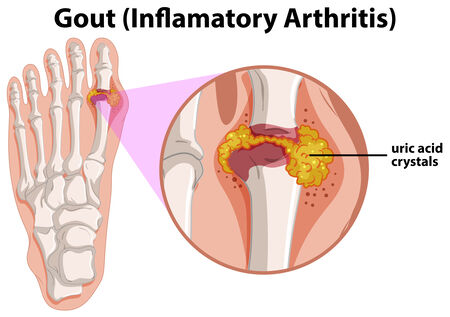
Symptoms and Causes of Gout
If you’re suffering from gout related joint paid, you’re not alone. This painful condition affects about four percent of the U.S. adult population.[1] What is gout, what are the symptoms, and what causes it? Here’s what you need to know!
What is gout?
Gout is a type of inflammatory arthritis characterized by pain and swelling in the joints. A gout flare often involves a single joint (most commonly the big toe), but it can sometimes affect multiple joints, including those in the feet, ankles, knees, and wrists.
Anyone can develop gout, but it’s more common in men than women and usually develops in middle-aged people.
What are the symptoms of gout?
Painful gout flares often start suddenly at night, with symptoms intensifying over a few hours. Signs and symptoms of a gout flare may include:
- Severe pain in one or more joints
- Swelling in and around the affected joint
- Stiffness in and around the affected joint
- Red, shiny skin over the affected joint
- A feeling of heat and tenderness in and around the affected joint
Symptoms typically last one to two weeks, and in between flares, people usually don’t experience symptoms. Some people may have frequent flares, while others may not have another flare for years.
If gout flares continually go untreated, hard, visible lumps made of uric acid crystals can form. These are called tophi. They can start out painless, however, over time, they can become painful and cause bone damage, soft tissue damage, and deformed joints. When gout becomes chronic and leads to joint damage, it’s called chronic gouty arthritis.
Additionally, untreated gout can make a person more likely to develop other serious health problems, including kidney stones, obesity, high blood pressure, cardiovascular disease, and diabetes.[2]
What causes gout?
Gout occurs when urate, a substance in your body, builds up and forms needle-shaped crystals in your joints. These crystals are what cause the symptoms mentioned above.
Urate comes from purines, which are found in your body’s tissues and in many foods, including red meat, organ meats, anchovies, sardines, mussels, scallops, trout, and tuna.
When purines break down, they become urate. Usually, urate passes out of your body through your urine. However, when too little is removed, urate builds up in your blood, causing crystals to form in your joints.
Certain risk factors may increase your chances of developing gout. These include:[2]
- Having a family history of gout
- Increasing age
- Drinking too much alcohol
- Eating foods rich in purines
- Drinking beverages sweetened with fructose (fruit sugar)
Some health conditions may also increase your risk of developing gout, including obesity, metabolic syndrome, chronic kidney disease, and high blood pressure.
The stigma surrounding gout
A national poll of gout patients found that shame, confusion, and lack of awareness keep many people with gout from receiving the treatment they need.[3] Respondents also said they feel embarrassed to discuss their disease and feel that others look down on those with gout.
One reason for this is because gout is often associated with eating too much unhealthy food and drinking too much alcohol. While diet can increase one’s risk, some people are simply predisposed to gout. Even if you think diet has played a role in your gout, self-blame is not the correct approach. A better approach is to learn from your past behaviors and make positive changes.
Getting treatment for gout
While gout cannot be cured, it can be well controlled with medications and lifestyle changes. Anti-inflammatory drugs can reduce symptoms during flares, while other types of medications can help reduce the amount of urate in the body, reducing the risk of complications.
Additionally, new therapies are currently being studied in clinical trials that show great promise for the effective treatment of gout.[4] While these new therapies are not yet available to the public, those with gout can access them through local research studies near you and which may be available at Triad Clinical Trials. These trials are free to participants and may include payment for time and travel.
If you’re interested in learning more about paid research studies for gout, sign up with Triad Clinical Trials today.
References:
- https://jamanetwork.com/journals/jama/fullarticle/2787544
- https://www.niams.nih.gov/health-topics/gout
- https://www.goutalliance.org/news-posts/2019/2/5/poll-stigma-amp-misinformation-may-stymie-gout-treatment
- https://www.healio.com/news/rheumatology/20210813/influx-of-newer-agents-in-gout-pipeline-hold-promise-for-shifting-treatment-paradigm

